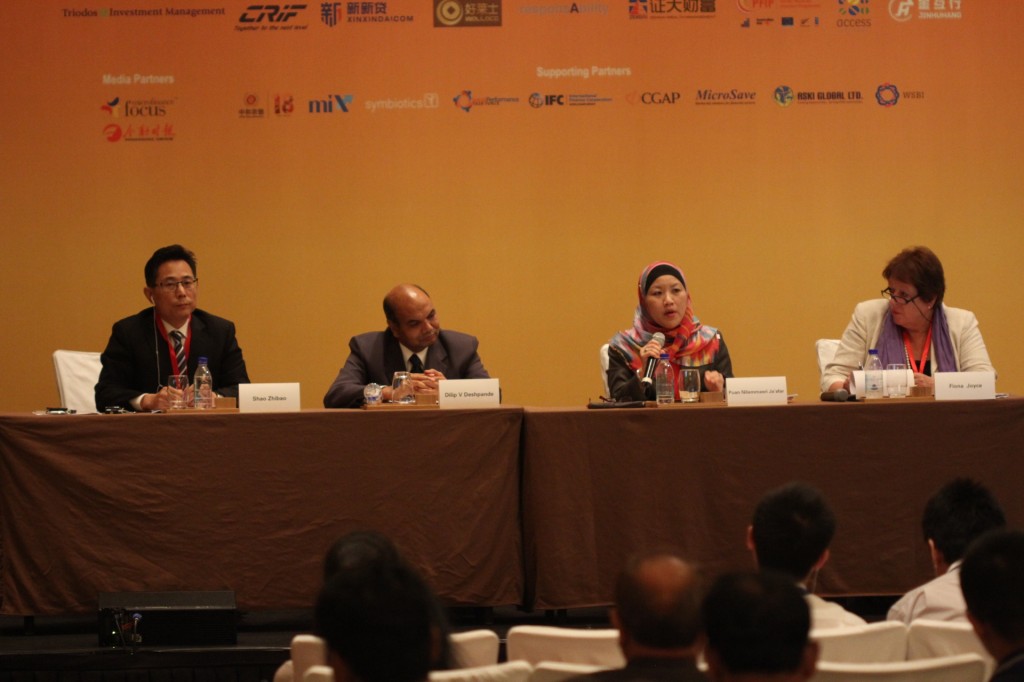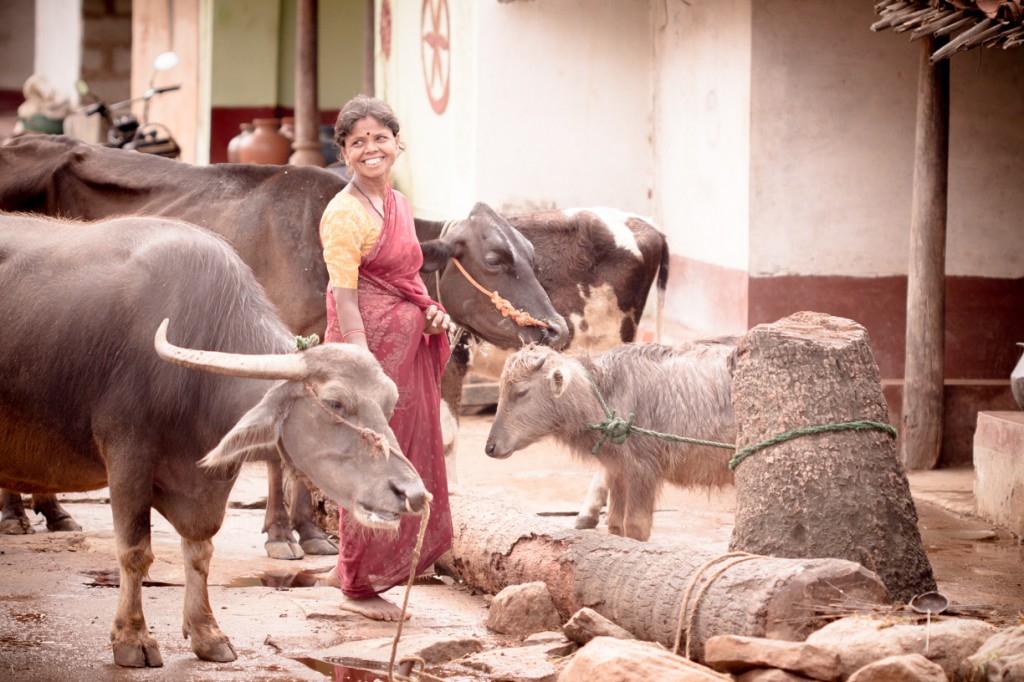The Role of State-Owned Banks in Financial Inclusion
 13:30 to 15:00 CST: Improving access to financial services for the world’s poor, to a large extent, hinges on the actions of State-owned banks (SOBs), often the primary (or only) provider of these crucial functions in many parts of the world. This panel at the 2014 Asia Microfinance Forum sought to address three key questions regularly raised about the role of state banks in improving world financial inclusion:
13:30 to 15:00 CST: Improving access to financial services for the world’s poor, to a large extent, hinges on the actions of State-owned banks (SOBs), often the primary (or only) provider of these crucial functions in many parts of the world. This panel at the 2014 Asia Microfinance Forum sought to address three key questions regularly raised about the role of state banks in improving world financial inclusion:
- How will SOBs work with other institutions that seek to provide financial services to the poor, including microfinance institutions? Should they focus their efforts on markets that these microfinance institutions are currently unable to reach?
- How should SOBs use new technology to reduce their costs and to innovate in the financial sector? How will new systems such as mobile money and Post Office devices help them expand financial inclusion while keeping costs down?
- How can these SOBs help provide the poor with useful financial services, while maintaining commercial viability and diminishing the quantity of public subsidies they absorb?
This session was moderated by Ms Fiona Joyce, Deputy Director and Head of WSBI Institutional Relations. The speakers were Ms. Puan Nilammasri Ja’afar, Senior Vice President & Head of Microfinance at Bak Simpanan Nasional (BSN) Malaysia, Mr. D.V Deshpande, Chief General Manager at National Bank for Agriculture and Rural Development (NABARD) India, and Mr. Shao Zhibao from the Postal Savings Bank of China (PSBC).
The three case studies, led by each of the speakers, demonstrated how state owned banks provide financial services to the poor in a commercially viable manner.
Ms. Puan Nilammasri Ja’afar began the session with a brief description of Bank Simpanan Nasional, which was established in 1974 under a Malaysian Act of Parliament. The bank’s objectives include promoting and mobilizing savings among the poor. A large organization, BSN has 6,800 employees, 401 branches with 100 percent nationwide coverage, 5,300 agents, 59 microfinance centers, 85 Islamic branches and 8.5 million customers. Financial inclusion is the driving agenda of BSN, said Ms. Ja’afar, who explained that they are “mandated to provide financial services to the community.”
Ms. Ja’afar called BSN agent banking a great innovation – a system in which customers do not need to show up at the brick and mortar branch to access services, but are instead provided with services by a branchless agent operating in their community. Ms. Ja’far noted that the set- up cost of a single brick and mortar branch is the same as the set-up cost for 100 agent bankers. With this agent banking system, BSN’s coverage has improved considerably: “Before agent banking was set up, BSN had about 43 percent coverage at sub-district level, but this has almost reached 99 percent through the BSN agent banking system” said Ms. Ja’afar.
Most companies in Malaysia are micro-enterprises. The majority of Malaysian micro-enterprises are self-funded, with only 17.4 percent relying on financing from financial institutions. Among other reasons, they did not use these institutions because they lacked supporting documents, they were not in a position to provide collateral and transaction cost is high compared to small loan size.
BSN ‘s Microfinance Program, launched in 2007, aims to provide financing facilities to viable micro-enterprises, the self- employed and individuals in a simple and convenient manner, i.e. with no collateral, minimum documentation and fast loan approval and disbursement times. The program is widely accessible through their large branch and agent banking network as well as their 59 dedicated microfinance centers. To date they have disbursed over US$ 250 million (RM 800 million) to 39,000 customers and the agent network has carried out over 11.5 million transactions for an amount of US$ 309 million (RM 990 million).
The BSN Microfinance program is however more than just loans. It also includes savings access, insurance/Takaful protection as well as advisory services including capacity building and skills training in cooperation with government agencies. The ultimate aim is to create a positive impact in the community and to graduate these companies to the next level of small and medium- sized enterprises (SME).
What is next for BSN? Ms. Ja’afar said that BSN intends to increase their access points for microfinance loan applications, cross-sell other microfinance customer products and develop further microfinance loan collection and distribution centers.
Second to speak on the topic of state-owned banks and financial inclusion was Mr. D.V Deshpande, Chief General Manager at the National Bank for Agriculture and Rural Development (NABARD) India. Per Mr. Deshpande, India has 1.2 billion people and very high population density, with 30 percent defined as poor and 9.4 percent unemployed. Per capita income in India is only 1,500 US dollars.
Mr. Deshpande noted that India’s banking structure is “quite elaborate,” referring to its beginnings during the British colonial era. The nation now has three main banking types: commercial, cooperative, regional rural. Among commercial banks, there are nationalized banks, private, and foreign. There are also development banks, including NABARD.
Mr. Deshpande described the history of Indian banking, including the 1969 nationalization of banks, and the creation of regional rural banks in 1975, followed by the liberalization of the Indian economy in 1991 and the launch of the self-help group pilot by NABARD in 1992. By 2008, the Indian government had announced a financial inclusion plan, which led to the National Rural Livelihood Mission.
The enabling environment for financial inclusion in India consists of three elements: a bank-led model (including state – owned banks and rural and regional banks), technology driven through PoS, micro ATM, smart cards and biometrics, as well as an outsourced or an agency bank correspondent model.
“Millions of accounts have been opened but many of them have remained dormant,” Mr. Deshpande said, a major area of concern. In response, the Indian government established a scheme where all the social benefits – pensions, scholarships, and others – are transferred automatically into citizen’s bank accounts. The Reserve Bank of India (RBI, Indian central bank) expects SOBs to approach financial inclusion as a business opportunity. The government has, however, created two funds that are administered by NABARD and destined respectively to strengthen the demand side through financial literacy and capacity building to support ICT solutions in banks on the supply side.
India takes a group approach, which is “quite famous” internationally, said Mr. Deshpande. It operates self-help groups (SHGs), which have covered some 95 million households – linking many women to a bank for the first time. There are also Joint Liability Groups (JLGs) which involve share croppers and oral leasees. So far, 529,000 such groups have been established and have availed of US $14 billion (INR 46 billion) in loans. SOBs have also provided support to MFIs in India in order to help them increase their credit outreach. Thus, said Mr. Deshpande “a multiple range of collaborative options are available in India in a ‘Blue Ocean Strategy’ approach.”
Mr. Deshpande touched on the usage of technology for financial inclusion. He noted that whereas technology requires some initial capital investment as well as customer segmentation efforts, it was cheaper in the long-term and served to increase the outreach of financial inclusion to a larger number of persons at a low cost. He warned that technology does have limitations, however, including connectivity problems. Nonetheless, technology has always been at the core of financial inclusion and is its “driving force”. This would be accentuated with the development of mobile banking, based on the large number of mobile phone users in India – approximately 74% of the population today.
In closing, Mr. Deshpande noted that Asian state owned banks hold a very important role in financial inclusion – and that financial inclusion is not philanthropy but an important business opportunity.
Last to speak was Mr Shao Zhibao from the Postal Savings Bank of China (PSBC). The focus of financial inclusion is to foster financial service innovation and financial system reform, he said. It should provide financial services for the general public both on time and conveniently. In this way, it can serve all communities, including “weaker segments” and provide better support to the development of the real economy in China.
Mr. Shao stressed that financial inclusion must be commercially viable and sustainable, and that financial inclusion differs from pure philanthropy or charitable programs. “Those financial services that are not commercially sustainable will not last long enough and will not reach the goal of inclusive finance,” he said.
“I firmly believe that these large state-owned banks shall take the leading role in inclusive finance,” said Mr.Shao, discussing their inherent advantages such as capital strength, their mature management, and large talent base, among other factors.
As state-owned banks, they should accomplish the social responsibilities of promoting financial inclusion, advancing green development and promoting social harmony. The promotion of financial and social inclusion is also a responsible contribution to the development strategy of the nation.
In China, there are more than 51 million micro-enterprises, said Mr. Shao, but only a small number of these organizations –some 20%- have access to loans from financial institutions. This large number of unbanked micro, small and medium- sized enterprises (SMEs) represents a large untapped business opportunity.
Mr. Shao shared the practices of PSBC in inclusive finance, noting that the bank – which has considered inclusion a top priority since its establishment in 2007 – takes full advantage of its vast urban and rural network. PSBC also enjoys huge capital and a strong grass-roots team, said Mr. Shao, allowing it to explore effective ways to develop financial inclusion.
“PSBC is deeply rooted in rural areas, with a vast and comprehensive network in both cities and rural areas,” said Mr. Shao. The bank has 39,000 branches, 70 percent of which are in rural areas – allowing PSBC to go the “last mile” to reach isolated farmers and others. PSBC has a strong presence in communities, Mr. Shao said, allowing them to perform social payments, pension payments, utility payments, and other convenient services.
The bank intends to expand its self-service channels, in an effort to deepen further its relationship with the communities it serves. “The practice of PSBC in financial inclusion has totally changed the traditional perception that big banks can only handle big businesses, while small banks are positioned better to handle small customers,” he said.
Mr. Shao shared his views on the future development of financial inclusion. He believes that it would be useful to create a platform for the exchange of financial inclusion experiences, so as to diminish differences in financial inclusion best practices in different countries. Such a platform, he argued, would “promote broad participation and exchange.”
Mr. Shao argued in favor of creating a conducive financial environment for furthering financial inclusion. To do this, it would be necessary to strengthen the role of government, in terms of policy guidance and incentives, to accelerate the building of social credit schemes and innovation in financial inclusion.
In closing, Mr. Shao said that the industry must “innovate marketing strategies and business models to reduce the cost, broaden the financial services range and outreach through innovating online service channels and management processing in order to improve the efficiency of financial services and to ensure that financial inclusion has a promising future.”
The panel on SOBs was facilitated by The World Savings and Retail Banking Institute, an organization comprised of savings and retail banks from 90 countries representing over 7,000 banks, with a focus on global banking issues, inclusive globalization, and the development goals of the G20. WSBI’s headquarters are located in Brussels.





